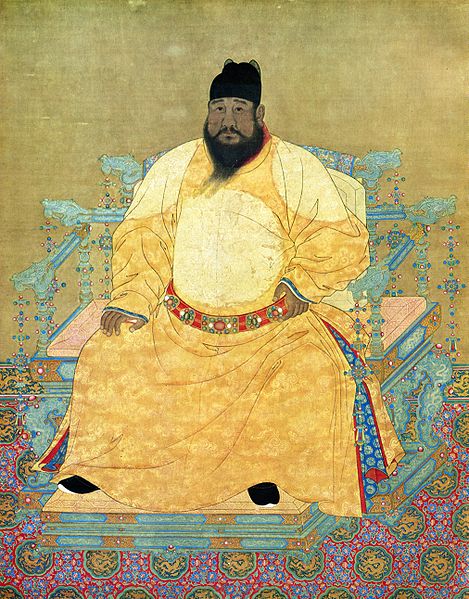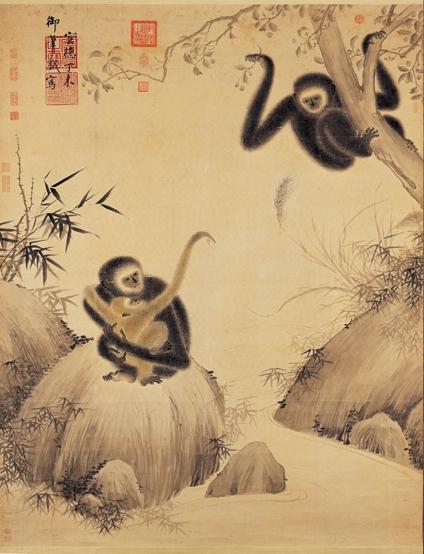<Back to Index>
- Philosopher Benedetto Croce, 1866
- Writer Karl Friedrich May, 1842
- Emperor of China Xuande, 1398
PAGE SPONSOR


The Xuande Emperor (宣德 [ɕɥántɤ̌]; February 25, 1398 – January 31, 1435) was Emperor of China (Ming dynasty) between 1425 – 1435. His era name means "Proclamation of virtue".
Born Zhu Zhanji, he was emperor Hongxi's son. Xuande was also fond of poetry and literature. Not like his father, Emperor Xuande (r. 1426 - 35) decided to keep Beijing as the capital and rule the dynasty according to the Yongle style. Then he ordered Zheng He to have another maritime expedition to continue the Yongle golden ages.
Xuande's uncle Zhu Gaoxu had been a favorite of Yongle for his military successes; but he disobeyed imperial instructions and in 1417 had been exiled to the small fief of Le'an in Shandong. When Zhu Gaoxu revolted, the new emperor Xuande took 20,000 soldiers and attacked him at Le'an. Zhu Gaoxu surrendered soon afterward. Zhu Gaoxu was reduced to a commoner and died from torture. Six hundred rebelling officials were executed, and 2,200 were banished. The Emperor did not wish to execute his uncle at the start, but later events angered the Emperor so much, that Zhu Gaoxu was executed through fire torture, and all Zhu Gaoxu's sons were executed as well. It is very likely that Zhu Gaoxu's arrogance, which is well detailed in many historic texts, offended the Emperor. A theory states that when the Emperor went to visit his uncle, Zhu Gaoxu intentionally tripped the Emperor.
Emperor
Xuande wanted to withdraw his troops from Annam, but some of his
advisors disagreed. After Chinese garrisons suffered heavy casualties,
the Emperor sent Liu Sheng with an army; but they were badly defeated
by the Annamese,
losing 70,000 men in 1427. The Chinese forces withdrew, and Xuande
eventually recognized the independence of Annam. In the north Xuande
was inspecting the border with 3,000 cavalry in 1428 and was able to
punish a raid by Mongols.
The Chinese let Arughtai's Eastern Mongols battle with Toghon's Oirat
tribes of the west. Beijing received horses annually from Arughtai; but
he was defeated by the Oirats in 1431 and was killed in 1434 when
Toghon took over eastern Mongolia. The Ming court then maintained
friendly relations with the Oirats. China's diplomatic relations with
Japan improved in 1432. Relations with Korea were good except they
resented having to send virgins occasionally to the Ming court's harem.
Xuande allowed Zheng He to make one more voyage; but such maritime expeditions by eunuch captains ended in 1434. A
privy council of eunuchs strengthened centralized power by controlling
the secret police, and their influence would continue to grow. In 1428
the notorious censor Liu Guan was sentenced to penal servitude and
replaced by the incorruptible Gu Zuo (d. 1446), who dismissed 43
members of the Beijing and Nanjing censorates for incompetence. Some
censors were demoted, imprisoned, and banished, but none were executed.
Replacements were put on probation as the censorate investigated the
entire Ming administration including the military. The same year the
Emperor reformed the rules governing military conscription and the
treatment of deserters. Yet the hereditary military continued to be
inefficient with poor morale. Huge inequalities in tax burdens had
caused most in some areas to leave their farms in the past forty years.
In 1430 Emperor Xuande ordered tax reductions on all imperial lands and
sent out "touring pacifiers" to coordinate provincial administration,
exercising civilian control over the military.
They attempted to eliminate the irregularities and the corruption of
the revenue collectors. Xuande often ordered retrials that allowed
thousands of innocent people to be released. Xuande died of illness
after ruling for ten years. The
Xuande Emperor ruled over a remarkably peaceful time with no
significant external or internal problems. Later historians have
considered his reign to be the Ming dynasty's golden age. The
Xuande Emperor was known as an accomplished painter, particularly
skilled at painting animals. Some of his art work is preserved in the National Palace Museum, Taipei, as well as in foreign collections, such as Arthur M. Sackler Museum (a division of Harvard Art Museum). Robert D. Mowry,
the curator of Chinese art at the Arthur M. Sackler Museum, described
him as “the only Ming emperor who displayed genuine artistic talent and
interest."
The Xuande Emperor was portrayed in contemporary court portrait paintings,
as well as in other works of art.